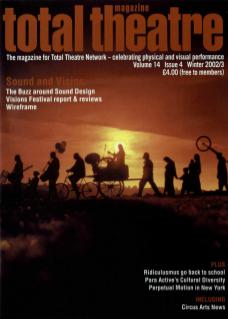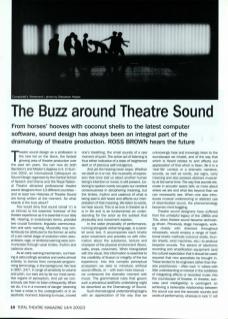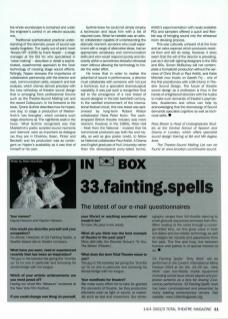Theatre sound design as a profession is the new kid on the block, the fastest growing area of theatre production over the past ten years. You can now do both Bachelor's and Master's degrees in it. In Summer 2002, an International Colloquium on Sound Design organised by the Central School of Speech and Drama and the Royal National Theatre attracted professional theatre sound designers from thirteen different countries – and at least two Histories of Theatre Sound are being written at the moment. So what exactly is the buzz about?
Few would deny that sound (small 's') is as intrinsic to the essential ‘liveness’ of the theatre experience as it is essential in our daily life. Hearing, in evolutionary terms, provided two crucial functions: linguistic communication and early warning. Musicality may contentiously be attributed to the former: an echo or a pre-verbal stage of evolution when sexual desire, rage, or territorial warning were communicated through vocal timbre, rhythm and cadence alone.
As an early warning mechanism, our hearing is astoundingly sensitive and works almost entirely, to borrow from computer-programming terminology, in the background. We hear in 360°, 24/7. In range of sensitivity to volume and pitch, our ears are by far our most sensitive organs of perception. And yet we consciously use them to listen infrequently. When we do, it is in a moment of danger (straining to hear a noise in the undergrowth) or in an aesthetic moment: listening to music, a loved one's breathing, the small sounds of a rare moment of quiet. The active act of listening is thus either indicative of a state of heightened alert or of precious self-indulgence.
And yet the hearing never stops. Whether we dwell on it or not, the musicality of expression that once told us about another human being's intention or mood, is still present. Listening to spoken words occupies our cerebral consciousness in deciphering meaning, but the timbre, rhythm and cadence of what is being said is still heard and affects our interpretation of that meaning. We listen to words, we hear sound. This is as true in theatre as it is in life and is as fundamental an understanding for the actor as the subtext that physicality and movement express.
In the wider physicality of performance, running alongside verbal language, is a parallel sonic text. It accompanies each kinetic actor movement and provides us with information about the substance, texture and character of the physical environment (floors, walls, props, costumes). When triangulated with the visual, this information is essential to the credibility of illusion or integrity of the live experience. Into this complex perceptual ecosystem we dare to introduce artificial sound effects, or – with even more bravura – we underscore the dramatic moment with music. The grammatical rules that govern such a precarious aesthetic undertaking might be described as the Dramaturgy of Sound.
Such dramaturgical understanding begins with an appreciation of the way that we unknowingly hear and knowingly listen to the soundscape we inhabit, and of the way that which is Heard relates to and affects our appreciation of that which is Seen. Be it in a 'real-life’ context or a dramatic narrative, sounds, as well as words, are signs, carry meaning and also possess abstract musicality at the same time. The way that sounds resonate in acoustic space tells us more about where we are and what lies beyond than we can necessarily see. When one also introduces musical underscoring or abstract use of disembodied sound, the phenomenology becomes mind-boggling.
Theatre sound designers have suffered from the unhelpful legacy of the 1960s and 70s, when theatre sound became technology driven. Previously, stage managers, working closely with directors throughout rehearsals, would employ a range of traditional kinetic methods (coconut shells, thunder sheets, wind machines, etc) to produce bespoke sounds. The advent of electronic recording and amplification equipment (and the cultural expectation that it should be used) required that new specialists be brought in. These tended to be engineers rather than theatre practitioners – often rock 'n' rollers with little understanding or interest in the subtleties of integrating effects or recorded music into the soundscape of theatre. In theatre, success (and intelligibility) is contingent on achieving a believable relationship between the sound cue and the acoustic sounds and words of performance, whereas in rock 'n' roll the whole soundscape is contained and under the engineer's control in an electro-acoustic mix.
Traditional sophisticated practical understanding of the dramatic power of sound was rapidly forgotten. The (sadly out-of-print) book Noises Off (1936) by Frank Napier – a stage manager at the Old Vic who specialised in ‘noise-making’ – describes in detail a sophisticated, experimental approach to the (low) technology of creating stage sound effects. Tellingly, Napier stresses the importance of collaborative partnership with the director and cast, communication skills, research and text analysis, which chimes almost precisely with the new orthodoxy of theatre sound design that is emerging from professional forums such as the Theatre-Sound Mailing List and the recent Colloquium. In his foreword to the book, Tyrone Guthrie describes how he hoped, one day, to stage a production of Maeterlinck's Les Aveugles, which contains such stage-directions as ‘The nightbirds exalt in the trees’. What Guthrie recognised was that Maeterlink's poetic scripted sound moments and 'silences' were as important as dialogue (as they are in Chekhov, Ibsen, Pinter and Beckett) and his production was as contingent on Napier's availability as it was that of himself or his cast.
Guthrie knew he could not simply employ a technician and issue him with a list of required cues. What he needed was an artistic collaborator capable of understanding the dramatic moment: someone who could experiment with a range of alternative ideas, had an appropriate vocabulary and communication skills, and who would respond quickly and discreetly within a sometimes stressful rehearsal room without allowing the technology to hinder the wider effort.
He knew that in order to realise the potential of sound in performance, a director must collaborate with someone with not just a technical, but a specialist dramaturgical capability. It was just such a recognition that led to the emergence of a new breed of sound designer in the late twentieth century. In the rarefied environment of the international festival circuit, this new breed was epitomised by long-term Robert Wilson collaborator Hans Peter Kuhn. The cash-strapped British theatre industry was more reticent. However, in the 1980s, Peter Hall – fresh from the National – insisted that his commercial producers pay both fee and royalty, as well as give poster credit, to fellow ex-National collaborator Paul Arditti. A Drama and English graduate of Hull University rather than the stereotypical pony-tailed techie, Arditti's experimentation with newly available PCs and samplers offered a quick and flexible way of bringing sound into the rehearsal room devising process.
This was culturally unheard of at the time and an extra expense which producers resisted then and still do today. However, it does seem that the will of the director is prevailing, just as it did with lighting designers in the 50s and 60s. Simon McBurney will not contemplate a Complicité production without the services of Chris Shutt or Paul Arditti, and Katie Mitchell now insists on Gareth Fry – one of the first practitioners with a BA (Hons) in Theatre Sound Design. The future of theatre sound design as a profession is thus in the hands of enlightened directors with the kudos to make such demands of theatre's paymasters. Academics and critics can help by acknowledging that the dramaturgy of Sound demands specialist cognitive as well as technical skills.
Ross Brown is Head of Undergraduate Studies at the Central School of Speech and Drama in London, which offers specialist sound design training at BA and MA degree level.
The Theatre-Sound Mailing List can be found at www.brooklyn.com/theatre-sound


